Drawing is an art of illusion—flat lines on a flat sheet of paper look like something real, something full of depth. To achieve this effect, artists use special tricks. In this tutorial I’ll show you these tricks, giving you the key to drawing three dimensional objects. And we’ll do this with the help of this cute tiger salamander, as pictured by Jared Davidson on stockvault.
Why Certain Drawings Look 3D
The salamander in this photo looks pretty three-dimensional, right? Let’s turn it into lines now.
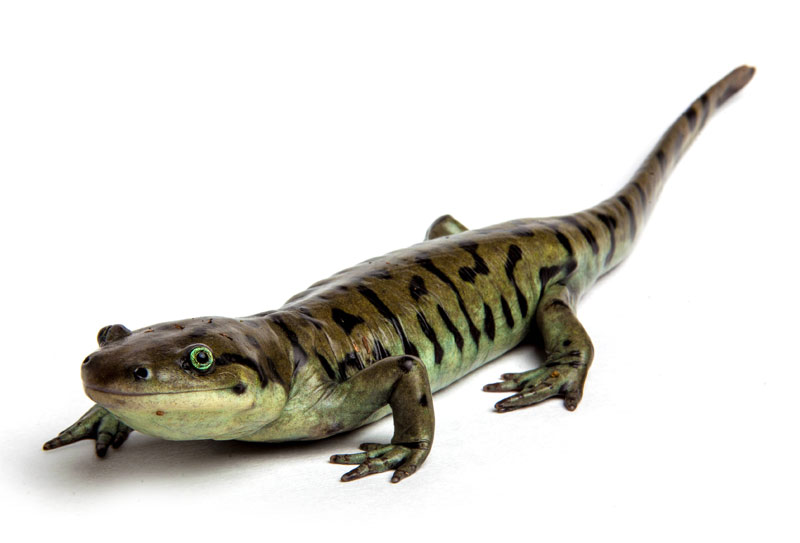
Hm, something’s wrong here. The lines are definitely correct (I traced them, after all!), but the drawing itself looks pretty flat. Sure, it lacks shading, but what if I told you that you can draw three-dimensionally without shading?

I’ve added a couple more lines and… magic happened! Now it looks very much 3D, maybe even more than the photo!

Although you don’t see these lines in a final drawing, they affect the shape of the pattern, skin folds, and even shading. They are the key to recognizing the 3D shape of something. So the question is: where do they come from and how to imagine them properly?


3D = 3 Sides
As you remember from school, 3D solids have cross-sections. Because our salamander is 3D, it has cross-sections as well. So these lines are nothing less, nothing more, than outlines of the body’s cross-sections. Here’s the proof:


A 3D object can be “cut” in three different ways, creating three cross-sections perpendicular to each other.


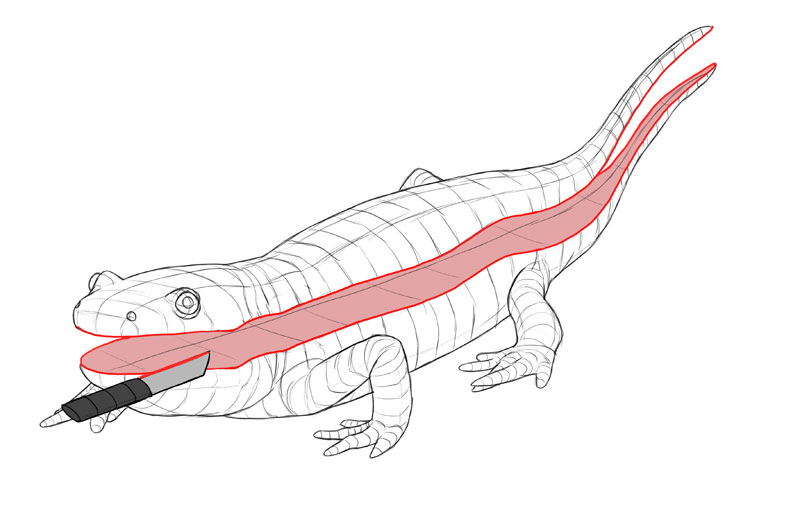
Each cross-section is 2D—which means it has two dimensions. Each one of these dimensions is shared with one of the other cross-sections. In other words, 2D + 2D + 2D = 3D!

So, a 3D object has three 2D cross-sections. These three cross-sections are basically three views of the object—here the green one is a side view, the blue one is the front/back view, and the red one is the top/bottom view.
Therefore, a drawing looks 2D if you can only see one or two dimensions. To make it look 3D, you need to show all three dimensions at the same time.

To make it even simpler: an object looks 3D if you can see at least two of its sides at the same time. Here you can see the top, the side, and the front of the salamander, and thus it looks 3D.

But wait, what’s going on here?

When you look at a 2D cross-section, its dimensions are perpendicular to each other—there’s right angle between them. But when the same cross-section is seen in a 3D view, the angle changes—the dimension lines stretch the outline of the cross-section.
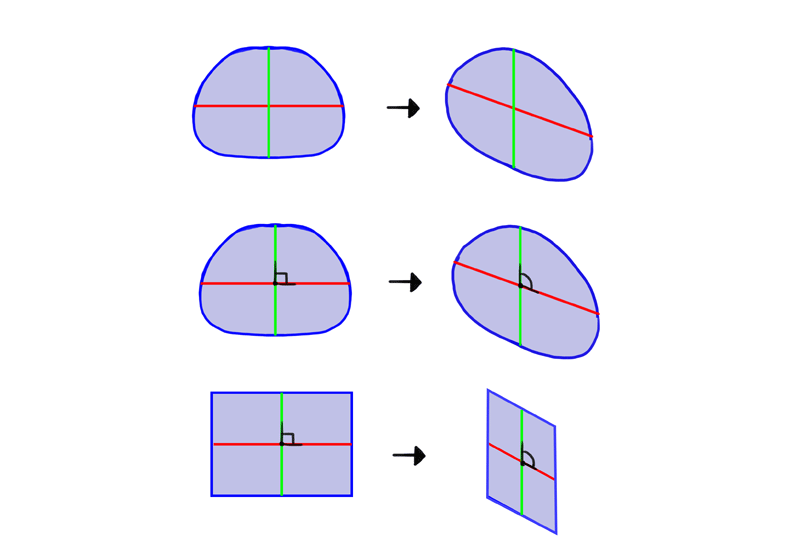
Let’s do a quick recap. A single cross-section is easy to imagine, but it looks flat, because it’s 2D. To make an object look 3D, you need to show at least two of its cross-sections. But when you draw two or more cross-sections at once, their shape changes.
This change is not random. In fact, it is exactly what your brain analyzes to understand the view. So there are rules of this change that your subconscious mind already knows—and now I’m going to teach your conscious self what they are.
The Rules of Perspective
Here are a couple of different views of the same salamander. I have marked the outlines of all three cross-sections wherever they were visible. I’ve also marked the top, side, and front. Take a good look at them. How does each view affect the shape of the cross-sections?
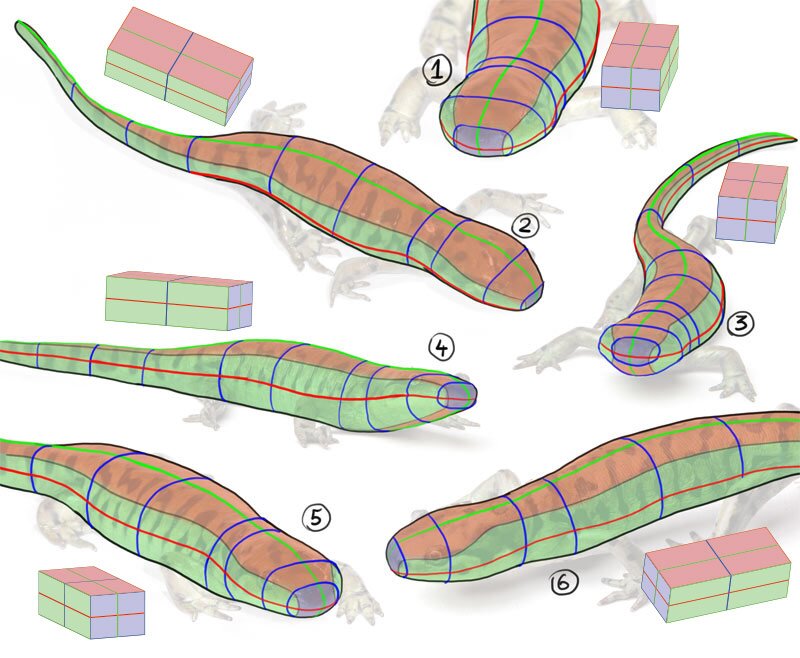
In a 2D view, you have two dimensions at 100% of their length, and one invisible dimension at 0% of its length. If you use one of the dimensions as an axis of rotation and rotate the object, the other visible dimension will give some of its length to the invisible one. If you keep rotating, one will keep losing, and the other will keep gaining, until finally the first one becomes invisible (0% length) and the other reaches its full length.
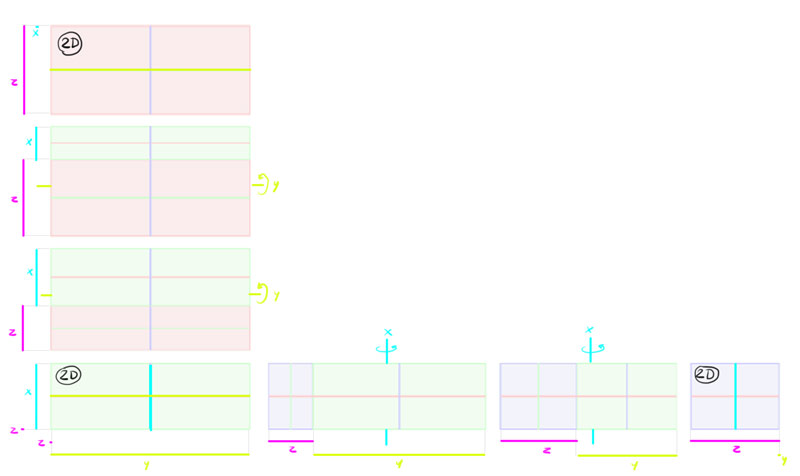
But… don’t these 3D views look a little… flat? That’s right—there’s one more thing that we need to take into account here. There’s something called “cone of vision”—the farther you look, the wider your field of vision is.

Because of this, you can cover the whole world with your hand if you place it right in front of your eyes, but it stops working like that when you move it “deeper” inside the cone (farther from your eyes). This also leads to a visual change of size—the farther the object is, the smaller it looks (the less of your field of vision it covers).

Now lets turn these two planes into two sides of a box by connecting them with the third dimension. Surprise—that third dimension is no longer perpendicular to the others!

So this is how our diagram should really look. The dimension that is the axis of rotation changes, in the end—the edge that is closer to the viewer should be longer than the others.

It’s important to remember though that this effects is based on the distance between both sides of the object. If both sides are pretty close to each other (relative to the viewer), this effect may be negligible. On the other hand, some camera lenses can exaggerate it.

So, to draw a 3D view with two sides visible, you place these sides together…

… resize them accordingly (the more of one you want to show, the less of the other should be visible)…

… and make the edges that are farther from the viewer than the others shorter.

Here’s how it looks in practice:

But what about the third side? It’s impossible to stick it to both edges of the other sides at the same time! Or is it?

The solution is pretty straightforward: stop trying to keep all the angles right at all costs. Slant one side, then the other, and then make the third one parallel to them. Easy!

And, of course, let’s not forget about making the more distant edges shorter. This isn’t always necessary, but it’s good to know how to do it:

Ok, so you need to slant the sides, but how much? This is where I could pull out a whole set of diagrams explaining this mathematically, but the truth is, I don’t do math when drawing. My formula is: the more you slant one side, the less you slant the other. Just look at our salamanders again and check it for yourself!

But if you want to draw creatures like our salamander, their cross-sections don’t really resemble a square. They’re closer to a circle. Just like a square turns into a rectangle when a second side is visible, a circle turns into an ellipse. But that’s not the end of it. When the third side is visible and the rectangle gets slanted, the ellipse must get slanted too!

How to slant an ellipse? Just rotate it!

This diagram can help you memorize it:

Multiple Objects
So far we’ve only talked about drawing a single object. If you want to draw two or more objects in the same scene, there’s usually some kind of relation between them. To show this relation properly, decide which dimension is the axis of rotation—this dimension will stay parallel in both objects. Once you do it, you can do whatever you want with the other two dimensions, as long as you follow the rules explained earlier.

In other words, if something is parallel in one view, then it must stay parallel in the other. This is the easiest way to check if you got your perspective right!

There’s another type of relation, called symmetry. In 2D the axis of symmetry is a line, in 3D—it’s a plane. But it works just the same!

You don’t need to draw the plane of symmetry, but you should be able to imagine it right between two symmetrical objects.

Symmetry will help you with difficult drawing, like a head with open jaws. Here figure 1 shows the angle of jaws, figure 2 shows the axis of symmetry, and figure 3 combines both.

3D Drawing in Practice
Exercise 1
To understand it all better, you can try to find the cross-sections on your own now, drawing them on photos of real objects. First, “cut” the object horizontally and vertically into halves.


Now, find a pair of symmetrical elements in the object, and connect them with a line. This will be the third dimension.

Once you have this direction, you can draw it all over the object.

Continue drawing these lines, going all around the object—connecting the horizontal and vertical cross-sections. The shape of these lines should be based on the shape of the third cross-section.

Once you’re done with the big shapes, you can practice on the smaller ones.
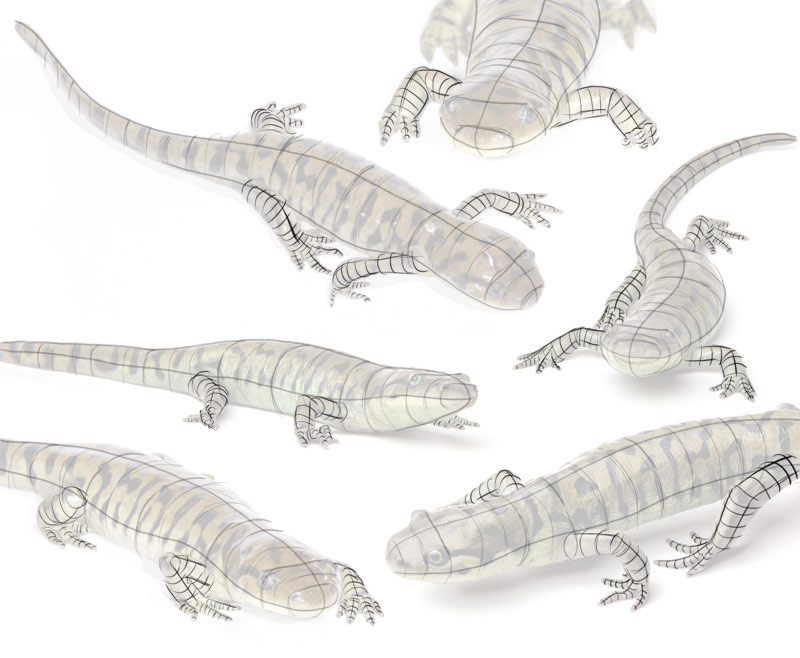
You’ll soon notice that these lines are all you need to draw a 3D shape!

Exercise 2
You can do a similar exercise with more complex shapes, to better understand how to draw them yourself. First, connect corresponding points from both sides of the body—everything that would be symmetrical in top view.

Mark the line of symmetry crossing the whole body.

Finally, try to find all the simple shapes that build the final form of the body.

Now you have a perfect recipe for drawing a similar animal on your own, in 3D!

My Process
I gave you all the information you need to draw 3D objects from imagination. Now I’m going to show you my own thinking process behind drawing a 3D creature from scratch, using the knowledge I presented to you today.
I usually start drawing an animal head with a circle. This circle should contain the cranium and the cheeks.

Next, I draw the eye line. It’s entirely my decision where I want to place it and at what angle. But once I make this decision, everything else must be adjusted to this first line.

I draw the middle line between the eyes, to visually divide the sphere into two sides. Can you notice the shape of a rotated ellipse?

I add another sphere in the front. This will be the muzzle. I find the proper location for it by drawing the nose at the same time. The imaginary plane of symmetry should cut the nose in half. Also, notice how the nose line stays parallel to the eye line.

I draw the the area of the eye that includes all the bones creating the eye socket. Such big area is easy to draw properly, and it will help me add the eyes later. Keep in mind that these aren’t circles stuck to the front of the face—they follow the curve of the main sphere, and they’re 3D themselves.

The mouth is so easy to draw at this point! I just have to follow the direction dictated by the eye line and the nose line.

I draw the cheek and connect it with the chin creating the jawline. If I wanted to draw open jaws, I would draw both cheeks—the line between them would be the axis of rotation of the jaw.

When drawing the ears, I make sure to draw their base on the same level, a line parallel to the eye line, but the tips of the ears don’t have to follow this rule so strictly—it’s because usually they’re very mobile and can rotate in various axes.

At this point, adding the details is as easy as in a 2D drawing.

That’s All!
It’s the end of this tutorial, but the beginning of your learning! You should now be ready to follow my How to Draw a Big Cat Head tutorial, as well as my other animal tutorials. To practice perspective, I recommend animals with simple shaped bodies, like:
You should also find it much easier to understand my tutorial about digital shading! And if you want even more exercises focused directly on the topic of perspective, you’ll like my older tutorial, full of both theory and practice.


3 Comments